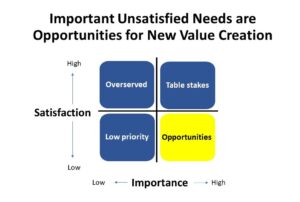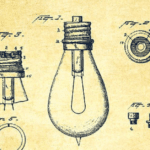3 Steps to Consistently Fill Your Pipeline with Only Good Ideas
It’s unusual for any organization to consistently fill their new product pipeline with only good ideas. On the contrary, the front end of the pipeline is usually bogged down with a lot of bad ideas. More than a few innovation teams have been terminated because they got overwhelmed trying to evaluate a lot of bad ideas. What then should we do to consistently fill the pipeline with only good ideas? Is that even possible? To answer those questions, let’s understand the problem.
The #1 cause of new product failure is misunderstanding the customers’ needs. The reason brainstorming doesn’t generate more good ideas is because the team has not sufficiently defined the target customers’ unmet needs. “Unmet” needs are important unsatisfied needs that are opportunities for innovation and growth. Because the customers’ needs have not been sufficiently defined, most ideas miss the mark and the firm is forced to waste time and money to figure that out.
This isn’t anyone’s fault. People have been doing the best they can with the knowledge and tools available. Until the advent of the Jobs-to-Be-Done (JTBD) innovation approach, defining the target customers’ unmet needs was very difficult. But JTBD has changed all that. Now firms can identify the biggest opportunities in virtually any market with precision so the team knows where to focus and what to do to consistently create unique value.
This means that firms can now avoid wasting time and resources generating, testing, and developing ideas that address unimportant needs, already well-satisfied needs, and/or phantom needs (needs that customers don’t really have). We know that, generally, only ideas that address important unsatisfied needs will succeed. Only addressing important unsatisfied needs will create competitive advantage. So, the first step to fill your pipeline with only good ideas is to identify your target customers’ important unsatisfied needs. These are opportunities for innovation and growth. The more important and less satisfied a need is, the greater the opportunity for innovation and growth it presents.

The second step is to determine which of the opportunities are attractive for your firm to pursue. This entails evaluating each opportunity with 5-7 common criteria such as strategic fit, relative advantage, time to commercialize, etc., plus maybe one company-specific criterion. Essentially, you want to select those opportunities that you believe the firm can address better than other competitive options and win. Remember, great new products and growth strategies are formulated by addressing an unmet market need with the firm’s relative strengths. That’s exactly what we’re doing here in a systematic fashion.
Now, the team is ready for Step 3: brainstorming ideas. Because the team has already 1) identified and validated the biggest opportunities in the market, and 2) selected those opportunities that are attractive to pursue, they will know where to focus and what to do to create unique value. They will know that they are addressing customer needs that are real, unmet, and attractive to the firm. They also will know exactly what the new product or service must do to be successful.
If you ever participated in a brainstorming session, then you are undoubtedly familiar with the adage, “there’s no such thing as a bad idea.” This is untrue, of course, but facilitators say it anyway because they know how important it is for everyone to feel safe enough to share their “crazy” ideas. The motivation is good, but saying this fib confuses people about what actually constitutes a good idea. It also encourages people to execute innovation “ideas-first” instead of “needs-first” which condemns companies to high failure rates.
A more useful definition of a “bad” idea is “any idea that does not address a validated market opportunity that the team has selected to pursue.”
And a “good” idea is “any idea that addresses a validated market opportunity that the team has selected to pursue.”
When I facilitate brainstorming sessions, I still say “There’s no such thing as a bad idea,” but now it’s true. The idea may not work out for various reasons, but it won’t be because the team didn’t understand the customers’ needs or know if the firm could address it and win.
Another benefit of doing the first two steps before brainstorming is that the firm is no longer dependent on the random nature of “inspiration” for good ideas. By executing the first two steps before brainstorming, firms are essentially preparing the soil so that good ideas can germination naturally and predictably. A well-defined customer need is the best creativity trigger.
Additionally, because the need statements are devoid of any solution language, the firm won’t be constrained by current product and service solutions. That increases the likelihood of generating breakthrough ideas.
It’s been said that the best way to resolve a problem is not to solve it, but to eliminate it. JTBD eliminates the problem of getting bogged down with a lot of bad ideas by enabling companies to fill their pipeline with only good ideas, i.e., ideas that address a big market opportunity that the team selected to pursue. You can do it, too.




